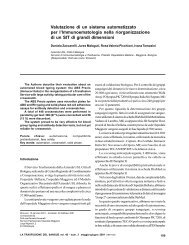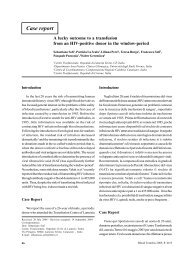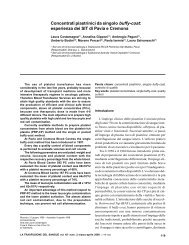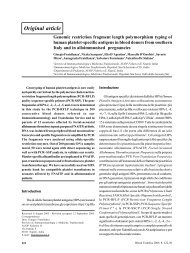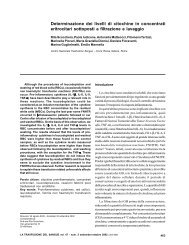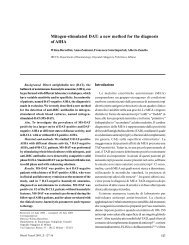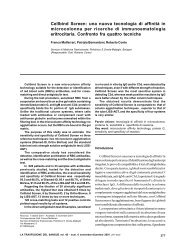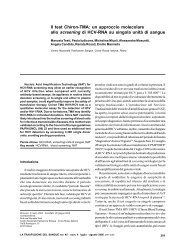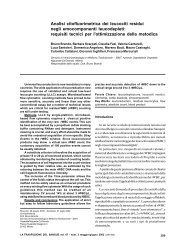Original article - Blood Transfusion
Original article - Blood Transfusion
Original article - Blood Transfusion
Create successful ePaper yourself
Turn your PDF publications into a flip-book with our unique Google optimized e-Paper software.
A Rughetti et al.TGF-b Transforming Growth Factor-b; IGF I and II InsulinLike Growth Factor I and II) derived from platelets andmorphogenically active proteins (bone morphogeneticproteins -BPM). The BPM are osteoinductive peptidesderived from platelets and belong to the TGF-b groupresponsible for the processes of bone generation andregeneration 6,9 . Local factors, cytokines, and growth factorsare necessary to trigger and maintain tissue regenerationprocesses. Furthermore, growth factors released locally inbone tissue are incorporated into the mineral matrix andreleased slowly during the break down of the matrix byosteoclasts or chondroclasts 9 .It has been hypothesised that there is an initial releaseof PDGF, TGF-b and IGF I and II at the site of a bone lesiondue to the effect of degranulation of platelets present inthe lesion 6,9,10 .PDGF stimulates mitosis of bone marrow stem cells andalso has an angiogenic effect, inducing and enhancing theformation of new capillaries in the site of the lesion 9 . At thesame time, TGF-b causes proliferation of fibroblasts andpro-osteoblasts and differentiation of these latter into moremature forms (osteoblasts) which are stimulated to producebone matrix, while the fibroblasts deposit a collagen scaffoldto support vessel growth 9,10 .The local presence of platelets carried by the bloodstream continuously provides the area of bone regenerationwith the necessary growth factors 6 . Subsequently releasedIGF I and II act on osteoblasts of the endosteum whichstarts to fill the trabeculae of the cancellous bone 10 .We used repeated infiltrations of hyperconcentrated,activated autologous platelets in the form of a gel (PG) intothe damaged site in order to enhance the role of platelettissue repair mechanisms.The application of PG in adjuvant treatment of bonetissue regeneration, incorporated appropriately into theoverall management and multidisciplinary care of the patient,is being shown to be effective. We found a clearly fasterresponse as well a much higher percentage of healing thanin the cases previously treated with only shock wave therapy.On the basis of our experience, we consider that it isdifficult to design protocols with certain prognosticevaluations because of the small size of our series, thelimited cases reported in the literature and, not least,because of the great variety of cases treated. However, theshort healing times and the good results obtained lead usto consider this new method as one of the most effectiveand promising treatments for pseudoarthrosis. Furthermore,the method is a simple and economic strategy for managingthis unpredictable pathology.dell’endostio che iniziano a riempire le trabecole dell’ossospugnoso 10 . L’infiltrazione ripetuta in situ di piastrineautologhe iperconcentrate e attivate in forma di gel (PG) èstata da noi utilizzata per esaltare il ruolo delle piastrine neimeccanismi di riparazione tessutale. L’applicazione del PG neltrattamento adiuvante della rigenerazione di tessuto osseo,inserita in maniera appropriata nel quadro complessivo epluridisciplinare della cura, sta dimostrando una evidenteefficacia. Abbiamo constatato una risposta decisamente piùrapida nonché una percentuale di guarigione di gran lungasuperiore rispetto ai casi trattati precedentemente solo conterapia ad onde d’urto. Sulla base della nostra esperienzariteniamo difficile la formulazione di protocolli con valutazioniprognostiche sicure data l’esigua casistica personale, la limitatacasistica reperita in letteratura e non di meno la grande varietàdelle caratteristiche dei casi trattati. Tuttavia, i tempi brevi diguarigione e i buoni risultati ottenuti ci inducono a considerarequesta nuova metodica come una tra le più efficaci e promettenti,nonché semplici ed economiche, nel trattamento di patologiecosì imprevedibili quali le pseudoartrosi.RiassuntoScopo dello studio è stato valutare l’efficacia di unprotocollo terapeutico con gel di piastrine, ricche di fattoridi crescita, iniettato a “cielo coperto” in corrispondenzadella lesione e associato ad onde d’urto elettromagnetiche,nel trattamento delle pseudoartrosi. Le onde d’urto,provocando delle microfratture sul sito della lesione,espongono una superficie maggiormente recettiva allostimolo dei fattori di crescita piastrinici particolarmentein senso osteogenetico. È stato selezionato un gruppo dipazienti che non ha risposto precedentemente al solotrattamento con un ciclo di onde d’urto. In tutti i casi èstato utilizzato gel piastrinico autologo. Il programma ditrattamento ha previsto in media 3 applicazioniradioguidate differite di 3-4 settimane l’una dall’altra. Innessun caso vi sono stati effetti indesiderati. Dei 16 pazientitrattati uno è stato escluso dallo studio poiché sottopostoprecocemente a reintervento chirurgico uscendo quindidal follow up. Un paziente è stato trattato con una singolaapplicazione poiché il rapido miglioramento clinico eradiologico non ha reso necessario procedere neltrattamento. Nella quasi totalità dei casi è stato osservatomiglioramento clinico e radiologico ed è stata possibilela rimozione dei mezzi di sintesi mediamente dopo10settimane dall’inizio del programma terapeutico; lavalutazione clinica e radiologica a 2, 4 e 6 mesi dalla 1 aseduta ha evidenziato graduale miglioramento del quadroclinico e progressiva formazione di callo osseo.42<strong>Blood</strong> Transfus 2004; 2: 37-43



